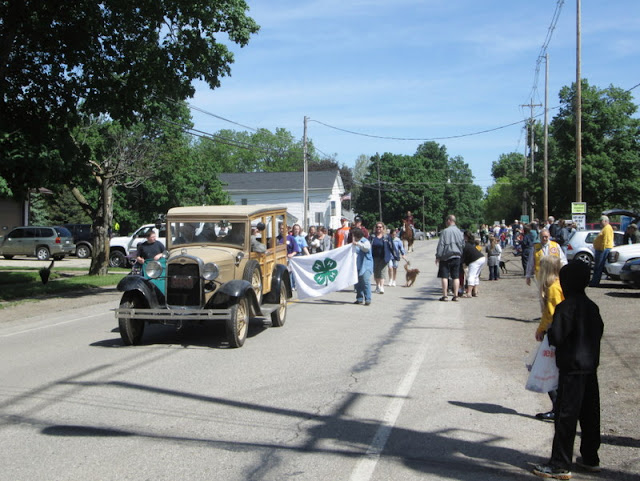So remember a little while ago that I said a little rain would be nice? There had been a good two weeks of planting at the NCRS and a little shower would be nice to help get things up and out of the ground. (Actually that was only 9 days ago.) Well we have had more than a little shower as it rained 4 days last week and pretty much all day yesterday. The NCRS received 1.24 inches last week and 2.4 inches yesterday, with a little more this morning. So it can stop any time. I did take a tour around this afternoon and this was on the Northeast side of Farm 7. What are the soybeans doing here? Looks like the backstroke. But really, this is about the only area that was showing some standing water, and this is on the low end of this field. The drainage tile is really doing its job and we are glad to have it. A lot of fields in the area have lakes. It is interesting to get perspectives from other parts of the country. Chance, our intern from the Texas panhandle, who actually grew up in Boise City in the Oklahoma panhandle, had no concept of tile drainage. Out there they do all they can to get water in the ground, and couldn't believe that we bury lines to remove it. Wish we could send them some. But it's a good education.
Just a little ways up the gradual slope, there is no water standing. Thank you tile.
Here is a corn plot also on Farm 7, also showing no ill effects from the nearly 4 inches of recent rain.
Here is some of our "production ground" on Farm 7. It is on too much of a slope for plots. But there are some no-till soybeans coming up. What I like here is that there are no corn stalks on the ground to deal with at planting. This is thanks to the Calmer stalk choppers that we installed on our corn head last fall for harvest. It did the job of chopping the corn stalks into short pieces and so there were no long stalks to get caught by the planter, especially with narrow 15" rows. This used to be a problem, but no more. Money well spent here.
Here is a nice pic looking up the hill on Farm 7 where we again have no-till soybeans planted.
Here is that field of wheat plots on Farm 4 that I showed us topdressing on May 1. The light strip has no N.
Here is what the wheat on Farm 3 looked like today. The heads are about 3/4 emerged, which would be Feekes growth stage 10.4. We haven't seen any leaf disease, thank goodness. But we will certainly spray a fungicide at flowering (stage 10.5+) for head scab which can be a problem sometimes.
Here again is that corn on Farm 3 that I showed when it got froze at early emergence and again with the twisted leaves caught at the tips. Well they have unrolled and are generally unscathed. But you can see the deadness at the tips where the leaves were wrapped and frozen. Corn can take a lot of early abuse as the growing point is still underground playing it safe.
Here is a look at this same experiment. The no-till corn is looking good so far. Like all of the corn in the area, it is kind of pale. This is no cause for concern, even though some may think something is wrong. Well there hasn't been much in the way of sunshine for 10 days. Green corn has active photosynthesis, and that doesn't happen as strongly when it is cool and cloudy. I hate to say it, but I have heard it said that some starter fertilizer will keep corn green even under these conditions. Not true, at least I haven't seen it. But give it a few days of sun and you will see it turn dark green and take off. And good row-placed fertilizer (especially AgroLiquid) will really give a benefit at that time.
Here is the tomato plot area. These plots aren't affected as they have their raincoats on. Now those are long plots, and Brian makes his crew walk it all the time. You can see the drip tape that runs under the plastic to give them a drink later when they need it.
So I hung around town this week hopeing to do some root digs like I did in Kentucky to get an early evaluaiton of treatments. But I wasn't going to slog around in the mud. Maybe later in the week if it stops raining. But I will try not to complain as it could always be worse. Our SAM Brad in South Central Nebraska sent me a number of pictures like this showing tordado damage on irrigation pivots by where he lives. This happened Monday evening. He said there were around 200 pivots down in a 50 mile stretch. This much damage probably won't be able to be fixed before it turns hot and dry this summer, assuming there is still corn in these fields. That much damage is hard to look at.
Well there are storms all over these days. Hope they stay away from where my loyal readers are. Fingers crossed.


















































